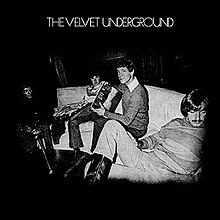
Back The Velvet Underground (album) Czech The Velvet Underground (Album) German The Velvet Underground (άλμπουμ) Greek The Velvet Underground (álbum) Spanish The Velvet Underground (albumi) Finnish The Velvet Underground (album) French The Velvet Underground (álbum) Galician The Velvet Underground (אלבום) HE The Velvet Underground (album) Hungarian The Velvet Underground (album) Italian
| The Velvet Underground | ||||
|---|---|---|---|---|
 | ||||
| Studio album by | ||||
| Released | March 1969 | |||
| Recorded | November–December 1968 | |||
| Studio | TTG, Hollywood | |||
| Genre | ||||
| Length | 43:53 | |||
| Label | MGM | |||
| Producer | The Velvet Underground | |||
| The Velvet Underground chronology | ||||
| ||||
| Singles from The Velvet Underground | ||||
| ||||
The Velvet Underground is the third studio album by the American rock band the Velvet Underground. Released in March 1969 by MGM Records, it was their first record with multi-instrumentalist Doug Yule, who replaced previous member John Cale. Recorded in 1968 at TTG Studios in Los Angeles, California, the album's sound—consisting largely of ballads and straightforward rock songs—marked a notable shift in style from the band's previous recordings. Lead vocalist Lou Reed intentionally did this as a result of their abrasive previous studio album White Light/White Heat (1968).[citation needed] Reed wanted other band members to sing on the album; Yule contributed lead vocals to the opening track “Candy Says” and the closing track "After Hours" is sung by drummer Maureen Tucker.
Thematically, The Velvet Underground discusses love, contrasting previous releases from the band. Reed devised its track order and based his songwriting upon relationships and religion. "Pale Blue Eyes" has been hailed as one of his best love songs,[by whom?] although "The Murder Mystery" is noted for its experimentation in a call-back to White Light/White Heat. Billy Name took the album's photograph of the band sitting on a couch at Andy Warhol's Factory. The recording process started at short notice and while the band had a high morale, they were ultimately disappointed that Reed had created his own mix of the final product.
Contemporary reviews praised the album, which was a turning point for the band. Nevertheless, The Velvet Underground failed to chart, again suffering from a lack of promotion by the band's record label. Reed played a dominant role in the mixing process and his own mix of the album, dubbed the "closet mix", was first released in the United States. MGM staff engineer Val Valentin was credited for a different mix which has been more widely distributed since then. Retrospective reviews have labeled it one of the greatest albums of the 1960s and of all time, with many critics noting its subdued production and personal lyrics. In 2020, Rolling Stone ranked it at number 143 on its list of the "500 Greatest Albums of All Time".
- ^ Unterberger 2017, chpt. 6.